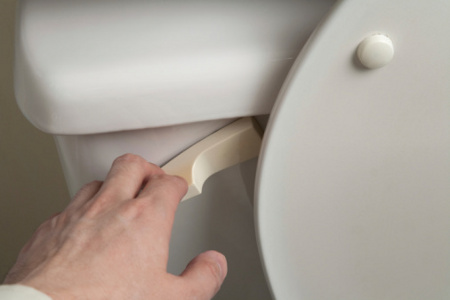Patient Guide: Total Hip Replacement Precautions and Helpful Hints
0 Comments
Taking Precautions
Following a total hip replacement, there are precautions you will need to follow to prevent your hip from dislocating. Your physical and occupational therapists will check which surgical approach you had and will review all precautions with you. Use this as a guide to help you in your post-surgery recovery in coordination with your therapist. Photo: Getty Images

If Your Surgeon Performed A Posterior Lateral Approach
-No hip flexion beyond 90 degrees; -No hip abduction past midline; -No hip internal rotation beyond neutral; or -A combination of all three movements. Photo: Getty Images

If Your Surgeon Performed An Anterior Lateral Approach
-No hip flexion beyond 90 degrees; -No hip extension beyond neutral; -No hip external rotation; or -A combination of all three movements.

Bed Position
-Keep abduction wedge or two pillows between thighs when lying on back at all times (posterior lateral approach); -Keep abduction wedge or two pillows between thighs and knees when turning to side (posterior lateral approach); -Avoid lying on non-surgical side to keep from abducting the surgical hip unless an abduction wedge or two pillows are between thighs and knees; -Do no sleep on surgical hip or on stomach; -Use a reacher to pull up covers instead of bending your hip past 90 degrees; Photo: Getty Images

Transfers
-To get out of bed, move legs toward surgical side or follow your physical therapists instructions; -Wear sturdy non-skid shoes, avoiding open toe, backless slippers or shoes; -Slide surgical leg out in front prior to standing; -Push up from the arms of the chair or surface you are seated on prior to transfer; -Always transfer towards non-surgical side using a walker; -Adhere to weight-bearing restriction if applicable; -When returning to bed, move legs toward surgical side or follow your physical therapists instructions. Photo: Getty Images

Sitting
-Do not sit in a low chair. Chair should have a straight back and arm rests. -Sit in a 90-degree position in a straight-backed chair. Avoid sitting in soft chairs, rocking chairs or stools and sofas; -Prior to sitting, make sure you feel the chair or surface you are sitting on against the back of your legs. After that, reach back one hand at a time, for the arms of the chair and slide surgical leg out front; -Do not cross legs at the ankles or knees; -Keep hips and knees level or hips slightly higher than knees; -Keep your feet and knees pointed straight ahead, not turned in or out and approximately six inches apart. -Sit with a pillow or abduction wedge between knees; -Use a reacher to pick up or reach for an item instead of leaning forward; -Try not to sit in the same position for more than 45 to 60 minutes at a time. Photo: Getty Images

Standing
-Wear sturdy, non-skid shoes; -Use a walker; -Slide surgical leg out in front prior to standing; -Push up from the arms of the chair or surface you are seated on. Gain balance before reaching for walker; -Do no pull up on the walker when rising as it could tip; -Do not pivot on surgical leg. Avoid internal rotation on posterior lateral hips, and external rotation on anterior lateral hips by picking up feet and taking small steps. -Do not bend over to pick up something. Use a reacher instead. Photo: Getty Images

Walking
-Wear sturdy non-skid shoes; -Use walker or assistive device your physical therapist recommended; -Follow weight-bearing restriction if applicable; -Advance your surgical leg first and then non-surgical leg keeping the walker within a comfortable step length in front; -Take small steps when turning and do not twist on either leg; -Walk slowly on uneven surfaces. Photo: Getty Images

Dressing
-Do not dress standing up. Sit on a chair or the edge of your bed if it is stable; -Do no bend over, raise your legs or cross your legs while you are dressing; -Use adaptive devices so that you will not bend too much. The occupational therapist will instruct you in the use of a reacher, long-handed shoehorn, elastic shoe laces and an aid to help you put on your socks. -When you are getting dressed, first put pant leg, sock or stocking on the surgical leg. -When you undress, remove clothes from your surgical leg last. Photo: Getty Images

Bathing and Showering
-Your occupational therapist will advise you on bathing and showering techniques; -He/she may teach you how to stand in the shower or instruct you in the use of a tub seat to sit on in the shower or bathtub; -Use a rubber mat on the tub or shower floor. Be sure to keep the bathroom floor dry and clean to avoid slipping; -Do not bend, squat or reach for anything while you are washing. Use a long-handled sponge and shower hose (if available) or a standard shower for washing. You may need assistance for hard-to-reach areas of your body. -Never sit down in the bottom of a regular bathtub. Photo: Getty Images

Toileting
-Use an elevated toilet seat or a raised commode to keep your knees lower than your hips. -Make sure the toilet paper is within reach. -Back up to the toilet seat until you feel it against the backs of your legs prior to sitting. -Slide surgical leg out in front prior to sitting and standing. -Reach back with one hand at a time for the arms of the commode or edges of an elevated toilet seat to lower yourself. Photo: Getty Images

Stairs
-Your physical therapist will instruct you in stair climbing with the proper assistive device and use of railing. -When you are going up, step up with your non-surgical leg first and then your surgical leg. -When you are going down, step down with your surgical leg first and then your non-surgical leg Photo: Getty Images

Car Transfers
-Your physical or occupational therapist will teach you how to get in and out of a car; -Enter the car from street level, not from a curb or doorstep; -Car seats should not be low. Sit on a pillow if you need to; -Before you get into the car, move the seat all the way back and recline the seat as needed. Also make sure you can slide easily on the seat material; -Back up to the car with the walker until you feel the car threshold against the back of your legs; -For support, reach back for the back rest and/or dashboard. Do not use the door; -Slide your surgical leg out in front prior to lowering yourself slowly to the seat; -Push yourself back onto the seat in a semi-reclined position; -Turn to bring one leg at a time into the car; -Break up long car rides. Stop, get out and walk about every two hours. -Do not drive until your doctor says it is okay. Photo: Getty Images

Basic Exercises
-Ankle pumps -- Slowly pump your ankles up and down several times. Relax. -Gluteal Sets -- Lie on back with legs straight. Squeeze buttocks together. Hold and repeat. -Quadriceps Sets -- While lying on your back, tighten your thigh muscles by pushing the back of your knee down into the bed. Hold this position for five to 10 seconds. Relax. -Short arc Quads -- Lie on back, with involved leg bent to 45 degrees, supported with a pillow, as shown. Straighten leg at knee. Return to start position. -Hip abduction -- Lie on back, legs together. Move leg out to side, keeping knee straight. Return to start position. -- Heel Slides -- Lie on back with legs straight. Slide heel up to buttocks. Return to start position. Repeat with other leg. -- Knee press -- You will need assistance with this exercise in order to position a towel roll under your ankle. Do not bend over and do it yourself. Once in position, lying on the bed with the rolled towel under your ankle, tighten your thigh muscle and press the knee down toward the bed. Hold for five to 10 seconds. Relax Photo: Getty Images
Add a CommentComments
There are no comments yet. Be the first one and get the conversation started!